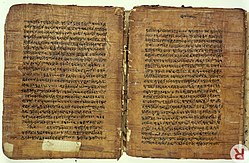Sanskrit
Sanskrit (संस्कृत) is an ancient Indo-European language. Many languages in the Indian subcontinent today are derived from Sanskrit.[3] Today, only about 14,000 people use it as their daily language.[1]
| Sanskrit | ||||
|---|---|---|---|---|
| संस्कृतम् saṃskṛtam | ||||
 The word Sanskrit (संस्कृतम्) written in Devanagari. | ||||
| Region | South Asia | |||
| Native speakers | 14,000[1] (2001) | |||
| Language family | Indo-European
| |||
| Writing system | No native script.[2] Today it is usually written in Devanagari, but it was also previously written in various Brāhmī-based scripts. | |||
| Official status | ||||
| Official language in | ||||
| Language codes | ||||
| ISO 639-1 | sa | |||
| ISO 639-2 | san | |||
| ISO 639-3 | san | |||
|
| ||||
| Part of a series on | |
|---|---|
|
| |
| Constitutionally recognised languages of India | |
| Category | |
| Scheduled Languages | |
|
A
| |
| Related | |
|
Official languages of India
|
Sanskrit is a standardized dialect of Old Indo-Aryan and has a linguistic ancestry that can be traced back to Proto-Indo-European. The Indo-European Aryan migration theory proposes that the Indo-Europeans migrated from the Central Asian steppes into the Indian subcontinent during the early 2nd millennium BC and brought the Indo-European language Sanskrit with them.[4] The main script used to write Sanskrit today is Devanāgarī. Historically, it was also written in the Kharoshti and Brahmic scripts.[5]
William Jones, working as a judge in India in the 18th century, studied Sanskrit and recognised its similarities to Latin, Greek and other European languages. That led to the Indo-European languages being recognised as a group of related languages stretching from Europe to India.
It is also one of the 22 officially recognised languages of India.
Literature
Sanskrit literature includes poetry and drama and has also scientific, technical, philosophical and religious texts.[6][7] Sanskrit continues to be widely used as a sacred language in Hindu religious rituals, and also some Buddhist and Jain practice in the form of hymns and chants.
Grammar
Sanskrit has a very complex grammar, with eight grammatical cases, three grammatical genders, and three grammatical numbers. Words are also described based on their qualities. Sanskrit is considered highly scientific, words in a sentence can describe the subject's number, gender and action.
Sanskrit Media
Rigveda (padapatha) manuscript in Devanagari, early 19th century. The red horizontal and vertical lines mark low and high pitch changes for chanting.
The Spitzer Manuscript is dated to about the 2nd century CE (above: folio 383 fragment). Discovered in the Kizil Caves, near the northern branch of the Central Asian Silk Route in northwest China, it is the oldest Sanskrit philosophical manuscript known so far.
One of the earliest known Sanskrit inscriptions in Tamil Grantha script at a rock-cut Hindu Trimurti temple (Mandakapattu, c. 615 CE)
The ancient Yūpa inscription (one of the earliest and oldest Sanskrit texts written in ancient Indonesia) dating back to the 4th century CE written by Brahmins under the rule of King Mulavarman of the Kutai Martadipura Kingdom located in eastern Borneo
References
- ↑ 1.0 1.1 "Comparative speaker's strength of scheduled languages − 1971, 1981, 1991 and 2001". Census of India, 2001. Office of the Registrar and Census Commissioner, India. Retrieved 31 December 2009.
- ↑ Banerji, Suresh (1971). A companion to Sanskrit literature: spanning a period of over three thousand years, containing brief accounts of authors, works, characters, technical terms, geographical names, myths, legends, and twelve appendices. p. 672. ISBN 978-81-208-0063-2.[dead link]
- ↑ "Sanskrit is second official language in Uttarakhand – The Hindustan Times". Hindustantimes.com. 19 January 2010. Archived from the original on 2011-11-02. Retrieved 2012-04-05.
- ↑ Witzel, Michael 2005. Indocentrism. In Bryant, Edwin & Patton, Laurie L. The Indo-Aryan controversy: evidence and inference in Indian history. London: Routledge.
- ↑ Brown, W. Norman (1953). "Script Reform in Modern India, Pakistan, and Ceylon". Journal of the American Oriental Society. 73 (1): 1–6. doi:10.2307/595755. ISSN 0003-0279.
- ↑ Katju, Markandey (9 June 2014). Sanskrit as a language of science. http://blogs.timesofindia.indiatimes.com/satyam-bruyat/sanskrit-as-a-language-of-science/.
- ↑ Katju, Markandey (5 December 2011). Markandey Katju: What is India?. http://timesofindia.indiatimes.com/india/What-is-India/articleshow/10994212.cms.
| This language has its own Wikipedia project. See the Sanskrit edition. |








